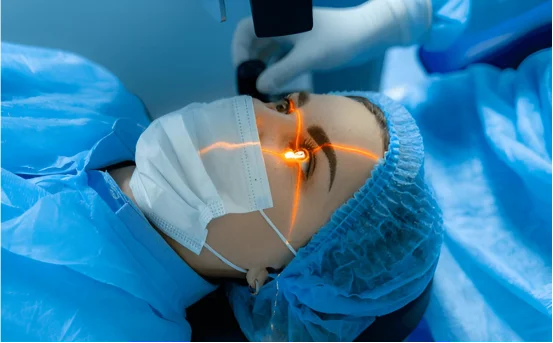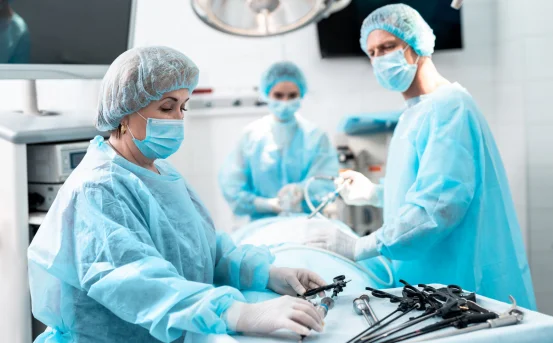The world of medicine is never still, and one of its most exciting recent advances is laser surgery. Thanks to its pinpoint accuracy, limited invasiveness, and speedier healing, lasers are steadily winning over both specialists and patients. From correcting vision to refreshing skin and tackling tumours, these glowing beams are finding homes in nearly every branch of care.
Among the various medical techniques, there are different types of laser surgery that cater to specific needs and conditions.
So, what does ‘laser surgery’ really mean and how does it do its job? And just as important, what kinds of procedures are on offer today?
What is Laser Surgery?
At its simplest, laser surgery fires concentrated light at a specific spot to cut, reshape, or destroy tissue. The letters in “laser” – Light Amplification by Stimulated Emission of Radiation – hint at the high-tech process behind that beam. Because the light is so focused, the surgeon can eliminate unwanted growths or modify organs while leaving the nearby skin and cells largely undisturbed.
That level of accuracy gives lasers a big edge over traditional instruments. Less contact translates into:
- Lighter bleeding
- Softer pain
- Smaller infection chances
- Speedier recovery
Why Laser Surgery is Preferred Today
Patients and their doctors keep leaning toward laser options, and the reasons are straightforward:
Minimally Invasive
Most laser jobs can be done through tiny openings or even with no cut at all. As a result, people spend less time in gowns and more time back in their normal routines.
One of the big attractions of laser surgery is how precise it can be. The focused beam zeroes in on tiny bits of tissue, which makes it a good fit for delicate spots such as the eyes or even areas deep in the brain. That pinpoint accuracy not only helps the doctor do the job right but also spares nearby healthy tissue as much as possible. Since the laser does most of the work with minimal contact, the chances of germs getting in and causing an infection drop sharply. Less touching means fewer openings, and fewer openings translate into a calmer immune response.
Because the procedure is gentle on the body, most patients find they bounce back quicker. Many report less pain, and the swelling usually clears up faster than it would after a traditional operation. That speedy recovery also fits nicely with today’s busy lives. Laser treatments are often performed on an outpatient basis, so after a few hours of observation, you can head home and sleep in your own bed instead of sharing a hospital room.
Laser technology has carved out a home in nearly every medical specialty, each making the most of its unique benefits.
- In ophthalmology :- LASIK remains the headline act. A carefully calibrated excimer laser reshapes the cornea to fix common vision problems such as nearsightedness, farsightedness, and astigmatism. PRK offers a similar outcome but takes a slightly different approach for certain patients. Occasionally, after cataract surgery, the membrane around the new lens can fog up; that’s when a YAG laser capsulotomy quickly clears things up and restores clear sight.
- Dermatology has also gone laser-mad :- Laser skin resurfacing can smooth out fine lines, scars, and sun spots, giving tired skin a fresh look with minimal downtime. Specialists have turned the same technology toward effortless hair removal by targeting and disabling the follicles that grow unwanted strands. Even old tattoos can meet their match, as colour particles are shattered into tiny pieces and gradually cleared away, often leaving nothing but a faint memory on the skin.
Types of Laser Surgery
The world of lasers has opened new doors for people looking to improve the texture and clarity of their skin. Among the most popular options are the CO2 laser, known for its deep resurfacing abilities; the Erbium laser, which is gentler but effective for less severe scars; the Nd:YAG laser that can treat both pigmentation and enlarged pores; and the Alexandrite laser, often chosen for its speed on lighter skin types. One of the biggest draws is that each session can be tailored to individual skin concerns, offering patients a refreshed appearance without the downtime of traditional surgery.
- Dental Laser Surgery :- Lasers have found a comfortable home in dental offices, where they make procedures quicker and more comfortable. For patients bothered by a “gummy” smile, gum contouring can create a more balanced look with very little bleeding. When cavities strike, a dental laser can pinpoint and remove decay almost painlessly, often eliminating the need for anaesthetic. Similarly, during teeth-whitening appointments, a laser activates the bleaching agent for brighter results in roughly half the time. Overall, these advantages translate to less discomfort and a faster visit.
- Oncology Laser Surgery :- In the fight against cancer, lasers are increasingly being deployed in early-stage cases. They are effective for cervical, esophageal, lung, and skin cancers, as well as for pre-cancerous lesions that could become problem areas. Using CO2 or Nd:YAG devices, surgeons can excise or shrink tumours while preserving more healthy tissue than with conventional methods. This precision not only makes the procedure easier to tolerate but also speeds up recovery by minimising collateral damage.
- Gynecological Laser Surgery :- Women battling conditions like endometriosis or those needing cervical lesion treatment now have less invasive options. Laser surgery can cut through scar tissue, remove abnormal cells, or tighten vaginal walls—all with minimal incisions. Because much of this work can be done on an outpatient basis, patients leave the clinic the same day and experience shorter recovery times compared to traditional surgery.
- Urological Laser Surgery :- Urology has also embraced lasers, most visibly in the treatment of kidney stones. Laser lithotripsy allows doctors to shatter stones into dust that can be passed naturally, sidestepping larger surgical cuts. The same technology is useful for ablating an enlarged prostate, providing relief from urinary symptoms with reduced bleeding and quicker catheter removal. Patients frequently report heading home in less than a day, a welcome contrast to the longer recoveries once required.
- Cosmetic Laser Surgery :- For those looking to refine their appearance without major surgery, cosmetic lasers offer an enticing menu. Laser lipolysis uses focused light to melt stubborn fat; stretch mark treatments can soften those faint lines; and targeted vein therapy eliminates spider veins in a flash. Each procedure is designed to yield noticeable results within a short session, allowing busy adults to sneak in treatment between errands rather than block off an entire weekend. The added bonus is minimal pain and downtime, making lasers a modern staple in aesthetic medicine.
Are There Any Risks Involved?
Even though laser surgery is often described as safe and precise, no procedure is entirely without risk. Potential complications a patient might encounter include:
- Infection, which is uncommon but possible if post-operative care guidelines are not followed.
- Scarring, especially if the skin has a tendency to heal unevenly or if protective dressings are not kept in place.
- Changes in pigmentation, leading to either lightening or darkening of the treated area, a concern that tends to affect people with darker skin tones.
- Burns, although rare, can occur when the device is misdirected or improperly calibrated.
- Temporary discomfort or sensitivity, which usually resolves within a few days once the treated area starts to heal.
- Discussing these risks with a board-certified surgeon or dermatologist is essential before signing consent paperwork.
Conclusion
Over the last few decades, laser technology has transformed a wide array of medical fields by delivering speed, precision, and remarkably quick recovery times. Surgeons now routinely use lasers for everything from vision correction and tumor removal to gentle skin resurfacing and even targeted dental treatment. These procedures are minimally invasive compared to traditional options, allowing many patients to return to normal activities sooner.
As research progresses, we can expect laser modalities to become even smarter, more customizable, and increasingly accessible throughout the healthcare system. Therefore anyone weighing the possibility of laser treatment—whether as a prospective patient, a referring clinician, or an SEO professional—should familiarize themselves with the various techniques in order to make confident, well-rounded decisions.























